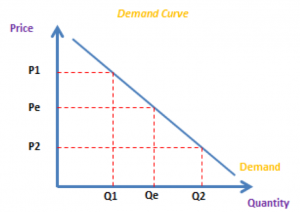Demand (AS/A Levels/IB/IAL)
Demand (AS/A Levels/IB/IAL)
Level: AS Levels, A Level, GCSE – Exam Boards: Edexcel, AQA, OCR, WJEC, IB, Eduqas – Economics Revision Notes
Demand
Demand is the quantity of a good or service that consumers are prepared to buy at a given time period.
Effective demand
Effective demand is influenced by prices. This is when consumers demand for a product has to be supported by their ability to pay for it.
e.g. If the average cost of flights to New York were increased from their effective demand price of £350 to £5000.
This would not be effective demand as customers would not be willing to pay £5000 for the flights.
Demand Curve
The demand curve shows the quantity of a good or service that consumers are willing to purchase at different price levels.
The demand curve is downwards sloping from top left to bottom right. This highlights an inverse relationship between price and demand.
Exam Tip – Draw all demand and supply diagrams accurately. Incorrect labeling can lose marks.
Why does demand increase as price falls?
1. Substitution Effect
As the price of a product falls (Pe – P2) it becomes cheaper than its competitors products. This increases demand for the cheaper product (Qe – Q2). Therefore consumers substitute the more expensive product for the cheaper
2. Income effect
When the price of a good falls from (Pe – P2) consumers are able to buy more of the same good. Therefore, demand for that product would increase from (Qe – Q2).
What causes a movement along the demand curve?
There is a movement along the demand curve only when there is a change in price.
What causes a shift in the demand curve?
A rightward shift in the demand curve is caused by an increase in demand
A leftward shift in the demand curve is caused by a decrease in demand
- Taste / Consumer Preference – if the popularity or preference for a certain product / service increase, the demand will rise, causing the demand curve to shift rightwards
- Real Incomes – a rise in real incomes will result in an increase in the amount of household income an individual has, meaning they have more money to spend on goods / services. Assuming the product is a normal good and has a positive YED, this will cause a rightward shift in the demand curve as demand grows
- Population – a larger population suggests there are more people in the market able to buy goods / services, leading to an increase in demand and a rightward shift in the demand curve
- Price of Substitutes or Compliments – If the price of a good rises, the demand for a substitute good will increase as more consumers will switch to a cheaper good, causing a rightward shift. However, the demand for a compliment good will decrease as a result of a price increase, causing a leftward shift
- Speculation – If the price of a good is likely to rise in the future, consumers may buy more of it now to avoid paying higher prices. This will cause the current demand to increase and shift right
Extension vs contraction of the demand curve
- A fall in price causes an EXTENSION in demand.
- A rise in price causes a CONTRACTION in demand.
OCR Spec – Additional Content
Types of Demand
Derived Demand
The demand for one good is related to the demand for another good. For e.g. the demand for labour is derived from the demand for the products produced
Composite Demand
The good demanded has more than one use. For e.g. milk can be used for the production of cheese and butter
Joint Demand
When the goods are bought in accordance with each other.
Competitive Demand
The goods demanded are in competition with other and substitutable. For e.g. An Apple iPhone is in competition with a Samsung phone
WJEC Spec – Additional Content
What is a Product Market?
A product Market is the interaction of goods and services. Firms produce goods / services which are then sold to consumers – who use their income generated from selling resources such as labour – to purchase them
Individual Demand and Market Demand
Individual Demand
This is measured by the quantity of a product bought at a specific point in time and refers to the demand of an individual / firm
Market Demand
The total of all individual demand in the market
Quick Fire Quiz – Knowledge Check
1. Define demand (2 marks)
2. Explain why the demand curve is downward sloping from left to right (4 marks)
3. Explain what a contraction and extension is in demand (4 marks)
4. Explain what causes a movement in the demand curve (4 marks)
5. Explain what causes shifts in the demand curve, by providing 5 examples (10 marks)
6. Explain why there is an inverse relationship between price and demand (4 marks)
7. Distinguish between a contraction and extension in the demand curve (4 marks)
Next Revision Topics:
- Aggregate Demand
- Demand Side Policies
- Price Elasticity of Demand
- Income Elasticity of Demand
- Cross Elasticity of Demand
A Level Economics Past Papers


